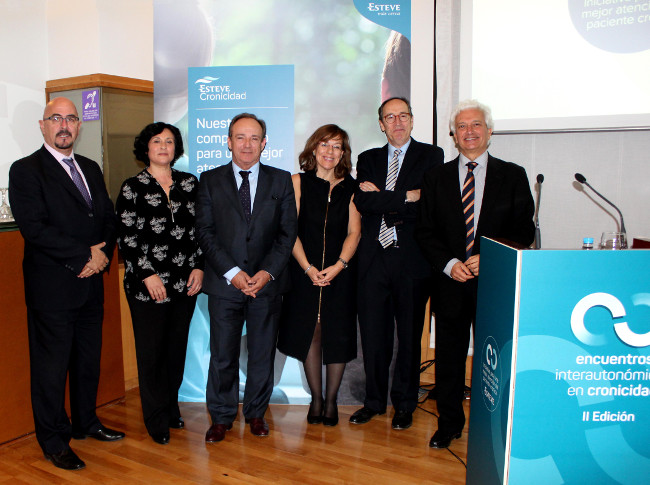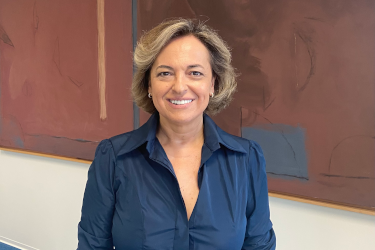15/04/2016
CHRONICITY WILL CHANGE THE HEALTHCARE AND SOCIAL PARADIGMS OF THE LAST 30 YEARS
Chronicity largely results from the fact that acute conditions are being treated successfully by the healthcare system, and has thus become the main environment of care.
This context will increase its influence due to larger ageing populations and to the complexity of social and healthcare needs in an environment of economic crisis. The development of chronicity-centered policies is the main challenge posed to health systems.
According to the conclusions of the II Interautonomic Meeting on Chronicity (EIC) organized by ESTEVE under the motto "making things happen", the key elements to successfully implementing these policies are: ICT integration, clinical leadership promotion, political determination, and professional training.

From left to right: Cesar Pascual, Mª Nuria Fernández de Cano, Javier Castrodeza, Carmen García, Carles Blay y Eugeni Sedano.
"Rather than an era of change, this is a change of era where new healthcare and social contexts and new needs will transform the paradigms of the last 30 years". The key factors to face this challenge are: ICT integration, professional leadership, active policies, and efforts in training leading to integrated and comprehensive care. These are the main conclusions reached at the II Interautonomic Meeting on Chronicity organized by ESTEVE and drawn from a questionnaire previously sent to chronicity responsibles at the different autonomous communities (ACs) and to members of the scientific committee of the Strategy to Approach Chronicity in the National Health System of the Ministry of Health.
This paradigm shift is determined by population ageing; increased chronicity, with greater prevalence of more complex diseases; a new social framework, with a more diverse society, new typologies and new resources made available; and the permanent context of economic crisis. "Spain gathers each and every variable in this equation", explains Dr. Carles Blay, a member of the scientific committee of the II EIC and Operational Head of the Program for the Prevention and Care of Chronicity of the Health Department of the Generalitat of Catalonia.
In addition to Dr. Carles Blay, the following members of the scientific committee participated in the II EIC: Carmen García Cubero, Head of the Chronicity Area of the Sub-Directorate General of Continuity of Care of the Community of Madrid; Mª Nuria Fernández de Cano Martín, Assistant Director-General of Continuity of Care of the General Directorate of Healthcare Coordination of the Community of Madrid.
What key factors can lead to a successful change? What barriers are to be overcome? Are we on the right track? The II Interautonomic Meeting on Chronicity "Making things happen", organized by ESTEVE and held recently in Madrid, sought to use the actual experience of planners to identify factors and levers for change, foster the participation of chronicity clinicians of reference at the ministerial level and at the different ACs to debate this and other issues of our system by means of a questionnaire submitted at the meeting.
Two factors must be taken into account: One, we shall be the third oldest country in the world in 2050, after Japan and South Korea. Two, the economic crisis will still affect our country in the coming years. "We must start this change now. We are at the beginning of a transformation of the current care model -now shifting to address the health requirements of people-, and most of this transformation should be completed in less than ten years".
One of the main conclusions was that, despite the varying implementation rates of this new care model among ACs, the elements that favor success and the barriers to be overcome are very similar. "Consequently, we can learn a lot from each other and find common strategies to make faster progress in the implementation of strategies in chronicity", said Dr. Blay, a member of EIC's scientific committee and presenter of the meeting, who also emphasized that "the conclusions reached are consistent with what is currently being published and performed at the international level, and so we are well positioned to make this change come true in the next few years".
The challenge: integrated and comprehensive care
In Spain, half of the population -20 million people- is affected by at least one chronic disease. In people over the age of 65, the mean is four chronic diseases according to the report issued by the Spanish Society of Healthcare Executives (SEDISA). Also, these conditions account for 80% of primary care consultations and 60% of admissions.
According to Dr. Blay, "chronicity is transforming the healthcare and social model into a completely different model, and the profiles and skills required to professionals will also be different. This challenge arises from the success obtained by the health system in the treatment of acute diseases. We must now head towards integrated and comprehensive care, where all the agents of the healthcare and social sectors learn to work together to address the needs of the patient on a global basis, including all the dimensions of each individual and his/her values and preferences".
This will entail breaking down traditional paradigms, passing from disease-based approaches to patient-based approaches, from paternalistic ways to deliberative medicine, from passive patients to active, empowered patients who can manage their own condition, from individual work to multidisciplinary and interdisciplinary collaboration -and integration of the healthcare and social environments. All for the purpose of being more effective, efficient and consistent with people's expectations.
According to the results obtained in the questionnaires completed at II EIC by chronicity responsibles in the different ACs and by members of the Strategy to Approach Chronicity in the National Health System of the Ministry of Health, four main levers to transform the current healthcare and social model in Spain were identified.
The first lever was ICT integration (including medical records, single records, etc.). These must be able to interoperate, allow data exchange and facilitate communication between professionals and between professionals and patients. "According to II EIC attendees, ICT integration seems to be the best way to overcome barriers to integrated care".
The second lever was having professional leaders who model the new healthcare proposals and transmit the benefits of chronicity-related strategies and integrated care. "The profile of professionals and healthcare teams must evolve and must basically do so according to the proposals made by clinicians of reference."
In this context, political determination becomes "a crucial issue that requires clear-sighted, assertive political leadership and a mid/long-term vision centered on people's needs". Finally, II EIC attendees considered two key elements: one, training and empowering professionals to successfully address the new realities; and two, having Primary Care adopt a lead role in the community to facilitate this transformation.
You can follow ESTEVE on Twitter at this link:
twitter.com/esteve_news.



